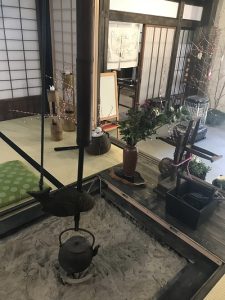大井宿、お魚の囲炉裏が可愛い(愛知県名古屋市千種区姫池通 古美術買取 古美術風光舎名古屋店)
2023.01.27
皆さま、こんにちは。スタッフNです。
今日も雪が降っておりますね。
出勤の方はくれぐれもご注意くださいませ。
いつも電車を降りたら温かいお茶を買うのですが、店に着く頃には冷めていて悲しい思いをしております。
この前はピザまんをカイロ代わりに手を温めていたのですが、食べようと思ったころには小さくつぶれておりました。
カイロ用と食べる用、2個買ってもいいかもしれません。
先日テレビを見ておりましたら、次は「シュヌレ」が流行ると言っておりました。
シュヌレとはシュークリームとカヌレを掛け合わせたスイーツでございます。
名古屋の洋菓子店が考案したそうで、調べてみると覚王山だったのです。
お店は予約制で、現在は予約も募集していないみたいなので残念ながら行くことができません。
Nはシュークリームが苦手なので食べられないのですが、全国ネットで話題のお店がこんな近くにあったとは感動です。
他にも覚王山にはおしゃれなお店がたくさんありますので、遊びに来がてら是非古美術風光舎にもお立ち寄りください。
さて、先日行った大井宿の囲炉裏が素敵だったのでご紹介いたします。
おさかなの形がなんとも可愛らしいですね。

旅館などに行く際などしか見られない囲炉裏ですが、落ち着いた空間になっていいですね。
BSで放送している「岩合光昭の世界ネコ歩き」で、たまに囲炉裏の傍で寝ている猫が登場致します。
そんなに近くて火傷しないのか、灰が飛んでこないか心配になりますが、本人たちは暖かそうにごろごろしております。
囲炉裏で焼いている餅や、魚目当てに来る猫もいらっしゃいました。
今回は囲炉裏について調べてみました。
囲炉裏(いろり:居炉裏とも表記)とは、屋内に恒久的に設けられる炉の一種でございます。
伝統的な日本の家屋において床を四角く切って開け灰を敷き詰め、薪や炭火などを熾すために設けられた一角のことを言います。
主に暖房・調理目的に用い、数える際には「基」を用います。
古くは、比多岐や地火炉とも言ったそうです。
地方により特有の形態を持つ囲炉裏は、その呼び名も地方ごとに異なり、多くの呼称がありました。
現在でも使われるものに、炉、地炉、ヒジロ、ユル、ユルイ、ユルリ、イナカ、エナカ、ヘンナカ、エンナカ、イリリ、イレ、シタジロ、スブト、ジリュなどがございます。
- 囲炉裏の使い方としましては、暖をとるため部屋の中央付近に置かれ、部屋中を暖めることです。
- 食物の煮炊きに用いられ、自在鉤(後述)や五徳を用いて鍋を火にかけ、炊飯をはじめとする、あらゆる煮炊きも行ないました。
- また魚などの食材を串に刺し、火の周囲の灰に立てたり、灰の中に食材を埋めて焼くことも多いです。
- 酒を詰めた徳利を灰に埋めて燗付けすることもございます。
- 北陸地方で竈が作られるようになったのは昭和30年代からで、それまで煮炊きは囲炉裏で行なっていたそうです。
- 夜間の採光に用いられたりもいたしました。
- 火が主要な照明であった近世以前において、囲炉裏は安全に部屋を照らすことのできる設備でした。
- 古くは炉辺の明かし台で松明を燃やし、手元の明かりとし、照明専用具として油や蝋燭がありました。
- 火棚を組み、衣類・食料・生木などの乾燥に用いたり、衣紋掛けを炉辺に置いて、濡れた着物を乾かしました。
- 囲炉裏には家族や人を集結させる場としての機能もございました。
- 家族の座る位置も決まっていたそうです。
- 囲炉裏の周囲の着座場所の名称は地方によって異なりますが、例えば横座、嬶座、客座、木尻または下座になるそうです。
- 土間から最も遠い席(横座)が一家の主人の席であり、土間に近い席(木尻)には子どもたちが座り、その間の両側に客人や主人の妻が座ったとか。
- 部屋中に暖かい空気を充満させることによって、木材中の含水率を下げ、腐食しにくくする効果もあったそうです。
- また薪を燃やすときの煙に含まれるタール(木タール)が、梁や茅葺屋根、藁屋根の建材に浸透し、防虫性や防水性を高めます。
- ただし、家の中に煙が充満することで眼病などの原因にもなるそうです。
温まるだけでなく色々な意味があったんですね。
古美術風光舎では鉄瓶などの買取もしております。
ではでは

Hello everyone. Staff N.
It’s snowing again today.
Please be careful if you are going to work.
I always buy hot tea when I get off the train, but by the time I get to the store, it’s cold and I’m sad.
The other day, I was warming my hands with a pizza bun instead of a warmer, but by the time I was about to eat it, it was crushed.
You may want to buy two, one for Cairo and one for eating.
When I was watching TV the other day, it was said that “Shunre” would be popular next time.
Schnure is a sweet that combines cream puff and canelé.
It was invented by a pastry shop in Nagoya, and when I looked it up, it turned out to be Kakuozan.
Unfortunately, I can’t go to the shop because it is a reservation system and it seems that they are not taking reservations at the moment.
N doesn’t like cream puffs, so he can’t eat them.
There are many other fashionable shops in Kakuozan, so please drop in at Antique Fukousha when you come to visit.
Well, the hearth of Ooi-juku, which I went to the other day, was wonderful, so I’d like to introduce it.
The shape of the fish is so cute.
The hearth is something you can only see when you go to an inn, but it’s nice to have a calm space.
In “Mitsuaki Iwago’s World Cat Walk” broadcasted on BS, sometimes a cat sleeping by the hearth will appear.
I was worried that they would get burned because they were so close, or that the ash would fly out, but they were lying around warmly.
There were rice cakes being baked in the sunken hearth, and there were even cats who came looking for fish.
This time, I tried to find out about the hearth.
An irori (hearth) is a type of hearth that is permanently installed indoors.
It refers to a corner in a traditional Japanese house where the floor is cut into squares and filled with ashes for lighting firewood or charcoal.
It is mainly used for heating and cooking purposes, and “base” is used when counting.
In the old days, it was also called Hinata or Jikarojika.
Inside the traditional Ainu house, Chise, the hearth “Apeoi” has a hook on which the hearth pot hangs.
The irori hearth, which has a unique shape depending on the region, has a different name depending on the region, and there were many names.
Furnace, earth furnace, hijiro, yuru, yurui, yururi, inaka, enaka, hennaka, ennaka, iriri, ile, shitajiro, subuto, jiryu, etc. are still used today.
The hearth is placed near the center of the room to warm the whole room.
It was used for cooking food, and it was used to heat a pot using a universal hook (described later) or a trivet, and to cook rice and all other types of cooking.
In addition, fish and other ingredients are often skewered and placed in the ash around the fire, or the ingredients are buried in the ash and grilled.
Sometimes sake-filled sake bottles are buried in ashes and warmed.
In the Hokuriku region, people started making hearths in the 30s of the Showa era, and it seems that until then, cooking was done in the hearth.
It was also used for lighting at night.
In pre-modern times, when fire was the primary form of lighting, the irori was a safe way to illuminate a room.
In the olden days, torches were burned on a fireplace beside the fireplace to provide light at hand, and oil and candles were used as lighting fixtures.
A fire shelf was built and used to dry clothes, food, raw wood, etc., and a clothes hanger was placed by the hearth to dry wet kimono.
The hearth also served as a place for families and people to gather.
It seems that the position where the family sits has also been decided.
The names of the seating areas around the irori hearth vary depending on the region, but for example, they are yokoza, 嬶座, kyakuza, kijiri, or shimoza.
The seat farthest from the dirt floor (yokoza) was the seat of the master of the family, and the children sat in the seats closest to the dirt floor (kijiri), with guests and the master’s wife sitting on either side of the space.
By filling the room with warm air, the moisture content in the wood was lowered, making it less likely to rot.
In addition, the tar (wood tar) contained in the smoke from burning firewood permeates building materials such as beams, thatched roofs, and thatched roofs, increasing their resistance to insects and water.
However, it seems that the smoke that fills the house can also cause eye diseases.
It was not only warm, but it had various meanings.
At Antique Fukousha, we also purchase iron kettles.
See you soon
- ********************
ご実家の整理やお片付けなどをされている方のご相談などが多くございます。
お寒くなってまいりましたので、お片付けなどくれぐれもご無理のないようになさってくださいませ。
風光舎では古美術品や骨董品の他にも絵画や宝石、趣味のお品など様々なジャンルのものを買受しております。
お片付けをされていて、こういうものでもいいのかしらと迷われているものでも、どうぞお気軽にご相談下さいませ。
また風光舎は、出張買取も強化しております。ご近所はもちろん、愛知県内、岐阜県、三重県その他の県へも出張いたします。
まずは、お電話お待ちしております。
愛知県名古屋市千種区姫池通
骨董 買取【古美術 風光舎 名古屋店】
TEL052(734)8444
10:00-17:00 OPEN
#骨董#買取#古い物 #古美術 #シュヌレ #囲炉裏 #大井宿

